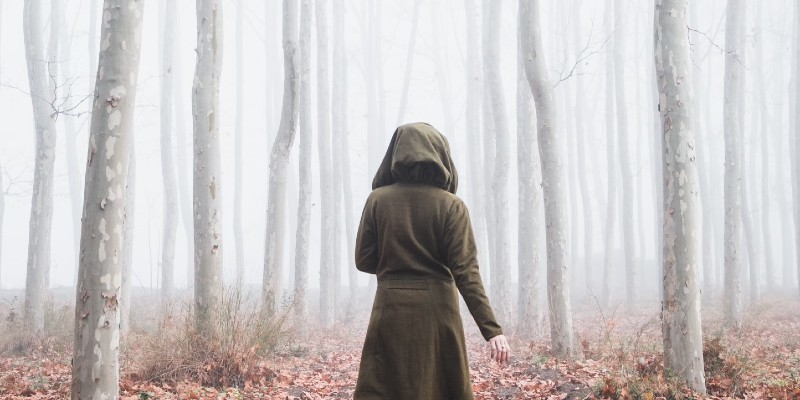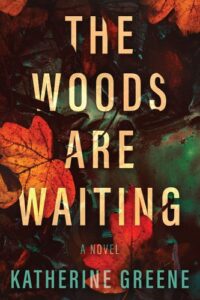“Put silver in your pockets, walk with dirt in your shoes, or he’ll poke your eyeballs from their sockets, and boil your bones in stew.”
(Katherine Greene is the pen name of two women writing twisty thrillers)
Our upcoming psychological thriller, The Woods Are Waiting, begins with a morbid nursery rhyme that highlights a very specific set of superstitions that are followed by an isolated community in the foothills of the Appalachian mountains. Silver and dirt have a long history of protective properties in many different cultures and the residents of the fictional closed off town of Blue Cliff, Virginia have held onto these beliefs and macabre traditions for generations.
So, what is it about superstitions and legends that when added to a story can make it a darkly thrilling read?
When we began to write our book, we were drawn to the idea that seemingly irrational concepts can take hold in people. And how, sometimes, it’s easier to believe in superstition than to accept a darker reality. According to a recent Gallup poll, one in four people in the United States consider themselves to be superstitious. We see this in everyday life. Some hotels don’t have a thirteenth floor. There are athletes that wear the same pair of socks for an entire season because they believe it brings them good luck. Gamblers in Las Vegas carry lucky charms, like a rabbit’s foot, thinking it will help them hit the jackpot. It’s often otherwise intelligent, sensible people who engage in these ritualistic behaviors that have no real basis in fact or reason. Despite the lack of any scientific basis, individuals adhere to them all the same and they are sometimes passed down from ancestors. This can result in customs becoming embedded in regional culture, like you often see in the southern United States. It’s this blind faith that intrigued us and became the backbone for our story.
Superstitions are defined as a belief that is not based on human reason or scientific knowledge. We also find that they can often be intertwined with local legends. The silver and dirt in The Woods Are Waiting is directly tied to a belief in the fictional Hickory Man, a malevolent spirit in the woods. In the same way that superstitions are passed on, so are urban legends and folklore, like the Moth Man in West Virginia and the Jersey Devil. These spooky stories can provide an undercurrent of darkness and tension that lends itself well to the unpredictable twists and turns of a thriller novel. When used as a foundation for the broader story, superstitions, particularly those that become ritualized and have an intrinsic connection to lore, can create a fraught, ominous atmosphere that fits well into the genre.
When you think about it, superstitious beliefs are perfect fodder for a psychological thriller. It can help to create a layered, nuanced plot that oozes suspenseful creepiness. The superstitions specific to an area, like the Appalachian mountains, can help a writer craft a tale that looks at our inherent need for community and control and weaves it with the darker aspects of humanity. How the characters navigate and react to superstition and legend builds depth that allows for the exploration of the psychology of human emotion, which can go to dark and twisted places.
Writing about superstitions, their origins, how characters are impacted by these attitudes, and whether they believe in these traditions, can lead to unique and exciting story lines. In The Woods Are Waiting almost everyone in the small Appalachian town are believers. Even the most ardent skeptics find themselves using artifacts they have been told will protect them. Our main characters find this reliance on generational customs an equal mixture of comforting and terrifying. It’s this dichotomy that shapes their interactions and the trajectory of the plot.
Before starting our writing process, we took a deep dive into some well known superstitions and their origins. It was interesting to find ways to thread them throughout the novel.
Here is a list of some superstitions, some we were already familiar with, and how they came about.
1. It’s bad luck to walk under a leaning ladder.
This originated over 5,000 years ago in Ancient Egypt. A ladder leaning against a wall creates a triangle, and Egyptians regarded triangles as sacred–as exhibited by their pyramids. To them, triangles represented the trinity of Gods, and to pass through a triangle was to desecrate them. Another exciting fact is that in England in the 1600’s, criminals were forced to walk under ladders on their way to the gallows!
2. Crafting poppets to heal or harm.
We used this particular superstition heavily in our book. Corn husk poppets have a long history in Appalachia. A poppet is a human-like figurine made of many different types of materials, particularly left over foodstuff items. There is a strong link between these small dolls and protection, with the idea being that the poppet is used as a way to make a connection with a person in need of healing. These are different from the well known voodoo dolls which are effigies created to inflict harm on someone.
3. Breaking a mirror leads to seven years of bad luck.
In ancient Greece it was common for people to consult mirror seers who told their fortune by examining their reflection. In the first century A.D. The Romans added a caveat to that superstition—they believed that people’s health changed in seven year cycles. So a distorted image, like that from a broken mirror surface, would result in seven years of ill-health and misfortune.
Incorporating superstitions into stories is not a new concept, with writers using this plot device for centuries. You find them in Homer and Shakespeare as well as more modern classics like Huckleberry Finn and To Kill a Mockingbird. Because of people’s inherent desire to not only understand, but to control things they can’t explain, these macabre traditions and beliefs can help to create an undeniably creepy atmosphere that is perfect for an intense and unpredictable thriller.
*


















